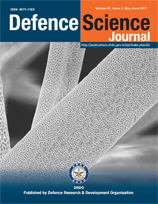An Approach to Reduce the Sample Consumption for LIBS based Identification of Explosive Materials
DOI:
https://doi.org/10.14429/dsj.67.10690Keywords:
Laser induced breakdown spectroscopy, Synthetic spectra, Identification, K – Nearest Neighbor,Abstract
An experimental design based on spectral construction, which has potential to minimise the sample consumption, the number of laser shots and time required to collect the data from laser induced breakdown spectroscopy for identification of the explosive materials is reported in the study. This approach is an ideal solution in the field of hazardous material detection, where the availability of the sample can be a serious limiting factor. The experimental data recorded on a set of five high energy materials has been considered to test the performance of the proposed methodology. Multiple spectra are constructed by assuming a normal distribution at each wavelength of the spectrum, where random numbers are generated using the mean and standard deviations obtained from arbitrarily chosen five experimental spectra from each class. The newly generated spectra are called as synthetic spectra. The correct classification obtained from – K - nearest neighbour combined with principal component analysis and partial least square – discriminant analysis demonstrated very promising results. The correct classification rates differed by only
4 per cent - 7 per cent as compared to conventional approach where experimental spectra alone are considered for the analysis. Further, when RDX is excluded, the obtained results are almost identical with conventional approach.
Downloads
Published
How to Cite
Issue
Section
License
 Where otherwise noted, the Articles on this site are licensed under Creative Commons License: CC Attribution-Noncommercial-No Derivative Works 2.5 India
Where otherwise noted, the Articles on this site are licensed under Creative Commons License: CC Attribution-Noncommercial-No Derivative Works 2.5 India


